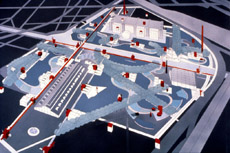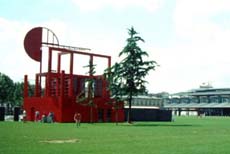index
La Villette
click on images for full-size:





One layer of the plan for Parc la Villette -- image courtesy of Bernard Tschumi Architects

Scene along a canal in Parc la Villette -- Photo by Peter Mauss/ESTO, courtesy of Bernard Tschumi Architects

The follies at la Villette

Using the Luxembourg Garden
I had hoped to be more impressed with Parc La Villette. The exquisitely designed deconstructive red follies do punctuate the park as advertised, but they seem to be ignored or taken for granted as background by the users of the park, just as are the sculptures in the Luxembourg Garden. The follies do have functions, a video center, a building for les arts plastiques, and so on. The people I saw were using them just as buildings. The same seemed true for the elaborate cross-cutting and conflicting circulation patterns; the theoretical niceties and complexities do not seem to be there for the users. Whatever its theoretical armature, the park's grammar did not seem to be deconstructive for its users, but the variety of spaces and activities functioned very well. As far as I could see, traditional park functions dominated and were not exceeded, nor made to reflect on themselves, nor made to show their multiplicity or their internal limits. This goes against the rationale given in the proposal for the park, but in a different way it shows that the design works, since it does succeed well in its assigned program of bringing together a great diversity of functions and locations. But if in addition La Villette was supposed to put pressure on our notions of what a park should be or how it should be used, the people I saw using the park seemed to feel no such challenge. In the 1860s Parc Buttes Chaumont created a fantasy world of temples, caverns, and strange spaces separated from the normal world yet corresponding to its literary dreams. In the 1980s Parc La Villette tried to fragment the normal world with deconstructive gestures that make it self-conscious of its artificiality. But mundane reality wins; people bounce casual soccer balls off the invisibly deconstructive monuments. The best part for me was the wandering path through the bamboo: like some areas of Central Park, it was its own world, an effective walled space, a "traditional" element. I spent five hours in Le Notre's park at Vaux le Vicomte and could have spent much more, but La Villette did not make me want to linger too long. Was it my fault? Not knowing how to look or read it? Perhaps we don't know how to live a deconstructive park. Still, if the citizens don't use it deconstructively, what should the theoreticians do?